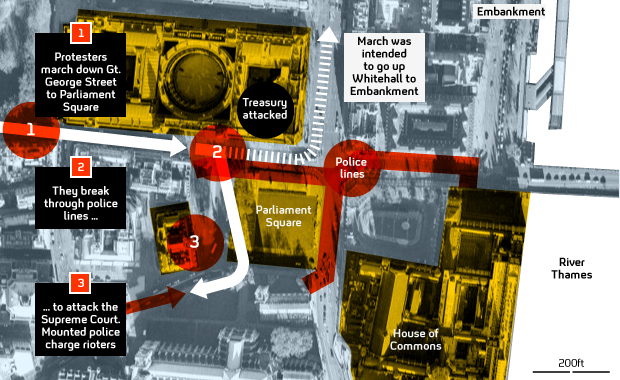Student protests: why did violence break out?
After the tuition fee protests in London end with injuries on both sides and damage to a series of buildings, Chief Correspondent Alex Thomson writes that violence was inevitable.
Thousands of demonstrators had been due to march from Bloomsbury, past Trafalgar Square, to Parliament, where some people had arranged to lobby MPs. They were then expected to make their way along Whitehall for a rally at Victoria Embankment.
The Metropolitan Police had agreed the route of the march with the University of London Union. The rally by the Thames had been organised by the National Union of Students and the University and College Union.
But before the marchers had even reached Trafalgar Square, a minority had already peeled off to make their own way to Parliament. At Trafalgar Square, demonstrators approached from several different directions.
By the time Westminster was reached, many people decided to stay put, whatever had been agreed beforehand with the police. It was around Parliament Square that the worst violence occurred, as officers tried to contain/kettle protesters to stop them from breaking off in separate directions.

Damned either way
As far as the Metropolitan Police are concerned, they were dealing with some people intent on extreme violence. They were damned either way: if they allowed people relatively free movement, there was a danger people would not follow the agreed route; if they kettled them, they would be accused of curtailing protesters’ freedom.
Mark Bergfeld, of the Education Activist Network, said: “I saw that people were being kettled until 1am on Westminster Bridge. They were held there without toilet facilities, without water or food for 10 hours.”
The police deny this, saying people were free to leave so-called containment areas if they wanted.
The NUS is not sure who was responsible for the violence outside Parliament, but believes anarchists were involved in the attack on Conservative Party headquarters last month.
Aaron Porter, NUS President, said in a statement: “On 9 December, NUS organised a lobby of Parliament and a rally on Victoria Embankment. Both of these passed off entirely peacefully and without incident. Unfortunately, another march not organised by NUS descended into chaos, as many of us will have witnessed in the media.
“NUS has consistently condemned violent protest as not only morally reprehensible, but also counter-productive.”
Let us start from the very obvious beginning and it is this: there was going to be considerable street violence yesterday and that was completely inevitable, writes Chief Correspondent Alex Thomson.
In more than 20 years of watching domestic and international rioting, I think I have picked up a thing or two about reading these events.
Yesterday was markedly different from previous marches which I have been on concerning student fees. Even outside London University, forming up, there were at least 200 youths at or near the front of the march already masked up.
The police too were much more in-your-face. At this stage still hard baseball caps on the heads, but riot helmets already hooked up to their belts.
Read more
Feyzi Ismail, who was involved in organising the march and acted as a steward, said: “The consensus is that this was a successful demonstration. The vast majority of people stuck to the agreed route. We’re not encouraging it or condoning it, but that is going to be the reaction of people when the police behave in such a disgraceful way. We have to condemn police brutality.”
This was a successful demonstration
Feyzi Ismail, march steward
Ms Ismail said the organisers had provided 50 stewards, but the police had insisted on leading the march at their own pace. This had slowed people down and some of them had become agitated and broken away.
“We managed to keep most people on the route. At Parliament Square, they wanted to stay because they knew what was happening inside Parliament. It was very difficult for the organisers to say, ‘okay, we have to be off’. When people wanted to leave, there was police kettling and people got really angry.”
Ms Ismail said a lesson for the future was using more stewards and involving the NUS in the arrangements.
Better intelligence
Brian Paddick, Liberal Democrat candidate for the London Mayoral elections in 2008 and a former Deputy Assistant Commissioner at the Metropolitan Police, said the operation had not been a success and better intelligence gathering was needed.
The police need to put more time and effort into intelligence gathering
Former Deputy Assistant Commissioner Brian Paddick
“The police need to put more time and effort into intelligence gathering to work out who the trouble-makers are. They need to identify people who are carrying weapons or wearing masks. It’s obvious that these people are not there to protest. They have to isolate them from peaceful protesters.”
Mr Paddick said the danger was that those intent on violence were able to “incite peaceful protesters to take on the police”, adding: “It would appear that protesters have got wise to containment tactics in that they’re splintering into small groups.”
He said the police had the power to insist that protesters removed their masks, while legislation made it clear that the direction of a march had to be agreed beforehand and “people are under an obligation to stick to the route”.
-
Latest news
-
Yungblud launches his own affordable music festival5m

-
Why these Americans want to quit their state9m

-
Company behind infected water outbreak are ‘incompetent’ says local MP5m

-
Israeli forces push deeper into Northern and Southern Gaza4m

-
India’s ‘YouTube election’: Influencers enlisted to mobilise youth vote6m

-




